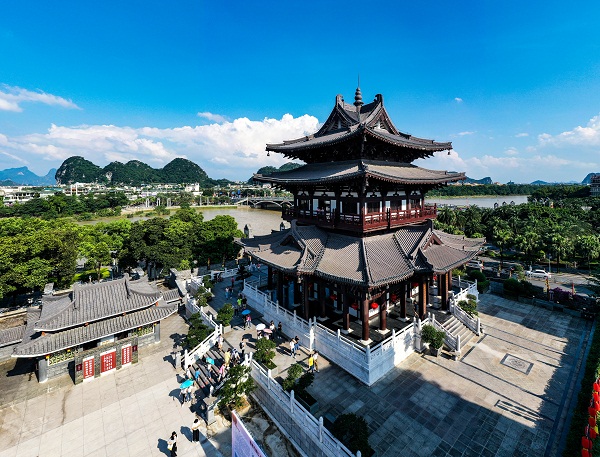Guilin boosts sustainability and green development
Protection of Lijiang River among top priorities of local plan
Guilin in the Guangxi Zhuang autonomous region is boosting green growth and prioritizing the preservation of the Lijiang River in its sustainable development plan, local officials said.
"Guilin's core competitiveness lies in the integration of ecology, culture and tourism, and it's all centered on the Lijiang River," said Zhou Jiabin, Party secretary of Guilin.
To protect the Lijiang River, the autonomous region issued the Guilin Lijiang River Ecological Protection and Rehabilitation Project Plan (2019-25) to restore the entire basin and manage projects in landscape, forest, field, lake and grass.
There are 147 key projects with a total planned investment of 91.9 billion yuan ($14.14 billion).
Guo Hongxing, director of the management committee of the Lijiang River, said projects such as upgrading villages along the Lijiang River and transforming tourism distribution centers are expected to be built for the comprehensive ecological development of the region, with a total investment of 3.2 billion yuan.
Zhou said Guilin aims to lead the high-quality economic development with the environmental protection of the Lijiang River, and continues to promote key industries.
"Promoting industrial revitalization is crucial to achieving the development goals of the 14th Five-Year Plan (2021-25)," he said. "It's the primary task for achieving high-quality development and important breakthroughs."
The city focuses on six industrial chains including high-end equipment manufacturing, biomedicine, new energy commercial vehicles and rail transit.
Guilin has also advanced the integrated development of urban and rural areas to rev up cultural prosperity and harmony.
Since 2013, it has invested more than 15 billion yuan to build 74 new urbanization demonstration towns. It has explored a new model of rural development that integrates modern agriculture, rural tourism and communities.
Zhou said that Guilin's industrial revitalization and the construction of international tourist resorts are not conflicting, but complementary.
The city has built a new tourism development model that integrates ecological protection, cultural tourism and industrial development.
It also introduced high-end cultural tourism projects such as the Sunac Cultural Tourism City and restored the Xiaoyao Building, Zhengyang east and west lanes, Caoping, Xingping and other villages as well as historical and cultural towns.
As one of the first group of tourist cities in China that opened to the outside world, Guilin has prioritized protecting the Lijiang River since the 1970s and insisted on "a blueprint for the end" in the construction of international tourist resorts.
In February 2018, the State Council approved the construction of the National Sustainable Development Agenda Innovation Demonstration Zone, which prioritized sustainable use of landscape resources in Guilin as well as the ecological restoration and environmental protection in karst rocky desertification areas.
"In the next step, we will actively explore the establishment of an ecological compensation mechanism for the Lijiang River, promote the comprehensive management of coastal villages, and deepen the integration of cultural, health, and tourism industries," Zhou said.
"We will continue to make every effort to promote the ecological protection and restoration of the Lijiang River and upgrade the development of Guilin as an international tourist resort."

The picturesque scene along the Lijiang River in Guilin, the Guangxi Zhuang autonomous region. CHINA DAILY

The Xiaoyao Building, built during the Tang Dynasty (618-907) in Guilin, is one of China's most famous ancient architecture relics. CHINA DAILY
